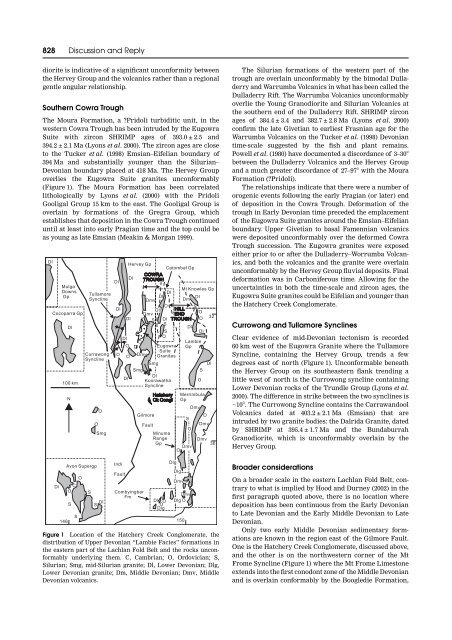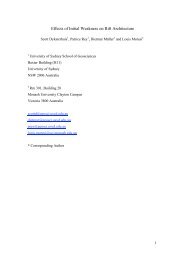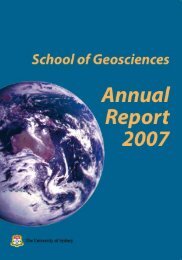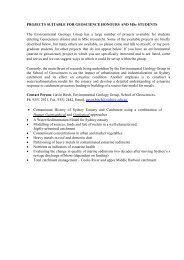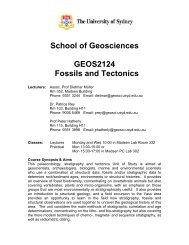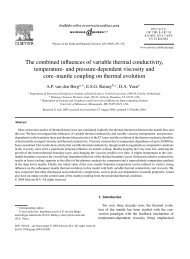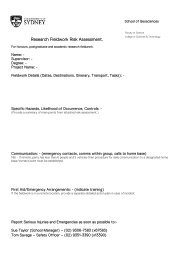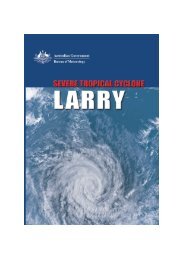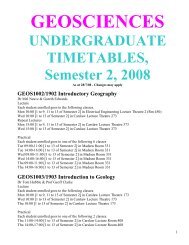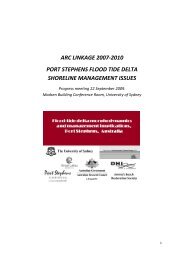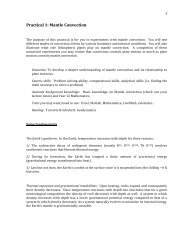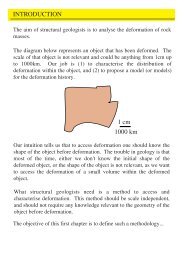View - School of Geosciences
View - School of Geosciences
View - School of Geosciences
You also want an ePaper? Increase the reach of your titles
YUMPU automatically turns print PDFs into web optimized ePapers that Google loves.
828 Discussion and Reply<br />
diorite is indicative <strong>of</strong> a significant unconformity between<br />
the Hervey Group and the volcanics rather than a regional<br />
gentle angular relationship.<br />
Southern Cowra Trough<br />
The Moura Formation, a ?Pridoli turbiditic unit, in the<br />
western Cowra Trough has been intruded by the Eugowra<br />
Suite with zircon SHRIMP ages <strong>of</strong> 393.0 ± 2.5 and<br />
394.2 ± 2.1 Ma (Lyons et al. 2000). The zircon ages are close<br />
to the Tucker et al. (1998) Emsian–Eifelian boundary <strong>of</strong><br />
394 Ma and substantially younger than the Silurian–<br />
Devonian boundary placed at 418 Ma. The Hervey Group<br />
overlies the Eugowra Suite granites unconformably<br />
(Figure 1). The Moura Formation has been correlated<br />
lithologically by Lyons et al. (2000) with the Pridoli<br />
Gooligal Group 15 km to the east. The Gooligal Group is<br />
overlain by formations <strong>of</strong> the Gregra Group, which<br />
establishes that deposition in the Cowra Trough continued<br />
until at least into early Pragian time and the top could be<br />
as young as late Emsian (Meakin & Morgan 1999).<br />
The Silurian formations <strong>of</strong> the western part <strong>of</strong> the<br />
trough are overlain unconformably by the bimodal Dulladerry<br />
and Warrumba Volcanics in what has been called the<br />
Dulladerry Rift. The Warrumba Volcanics unconformably<br />
overlie the Young Granodiorite and Silurian Volcanics at<br />
the southern end <strong>of</strong> the Dulladerry Rift. SHRIMP zircon<br />
ages <strong>of</strong> 384.4 ± 3.4 and 382.7 ± 2.8 Ma (Lyons et al. 2000)<br />
confirm the late Givetian to earliest Frasnian age for the<br />
Warrumba Volcanics on the Tucker et al. (1998) Devonian<br />
time-scale suggested by the fish and plant remains.<br />
Powell et al. (1980) have documented a discordance <strong>of</strong> 3–30<br />
between the Dulladerry Volcanics and the Hervey Group<br />
and a much greater discordance <strong>of</strong> 27–97 with the Moura<br />
Formation (?Pridoli).<br />
The relationships indicate that there were a number <strong>of</strong><br />
orogenic events following the early Pragian (or later) end<br />
<strong>of</strong> deposition in the Cowra Trough. Deformation <strong>of</strong> the<br />
trough in Early Devonian time preceded the emplacement<br />
<strong>of</strong> the Eugowra Suite granites around the Emsian–Eifelian<br />
boundary. Upper Givetian to basal Famennian volcanics<br />
were deposited unconformably over the deformed Cowra<br />
Trough succession. The Eugowra granites were exposed<br />
either prior to or after the Dulladerry–Worrumba Volcanics,<br />
and both the volcanics and the granite were overlain<br />
unconformably by the Hervey Group fluvial deposits. Final<br />
deformation was in Carboniferous time. Allowing for the<br />
uncertainties in both the time-scale and zircon ages, the<br />
Eugowra Suite granites could be Eifelian and younger than<br />
the Hatchery Creek Conglomerate.<br />
Currowong and Tullamore Synclines<br />
Clear evidence <strong>of</strong> mid-Devonian tectonism is recorded<br />
60 km west <strong>of</strong> the Eugowra Granite where the Tullamore<br />
Syncline, containing the Hervey Group, trends a few<br />
degrees east <strong>of</strong> north (Figure 1). Unconformable beneath<br />
the Hervey Group on its southeastern flank trending a<br />
little west <strong>of</strong> north is the Currowong syncline containing<br />
Lower Devonian rocks <strong>of</strong> the Trundle Group (Lyons et al.<br />
2000). The difference in strike between the two synclines is<br />
~10. The Currowong Syncline contains the Carrawandool<br />
Volcanics dated at 403.2 ± 2.1 Ma (Emsian) that are<br />
intruded by two granite bodies: the Dalrida Granite, dated<br />
by SHRIMP at 395.4 ± 1.7 Ma and the Bundaburrah<br />
Granodiorite, which is unconformably overlain by the<br />
Hervey Group.<br />
Broader considerations<br />
Figure 1 Location <strong>of</strong> the Hatchery Creek Conglomerate, the<br />
distribution <strong>of</strong> Upper Devonian “Lambie Facies” formations in<br />
the eastern part <strong>of</strong> the Lachlan Fold Belt and the rocks unconformably<br />
underlying them. C, Cambrian; O, Ordovician; S,<br />
Silurian; Smg, mid-Silurian granite; Dl, Lower Devonian; Dlg,<br />
Lower Devonian granite; Dm, Middle Devonian; Dmv, Middle<br />
Devonian volcanics.<br />
On a broader scale in the eastern Lachlan Fold Belt, contrary<br />
to what is implied by Hood and Durney (2002) in the<br />
first paragraph quoted above, there is no location where<br />
deposition has been continuous from the Early Devonian<br />
to Late Devonian and the Early Middle Devonian to Late<br />
Devonian.<br />
Only two early Middle Devonian sedimentary formations<br />
are known in the region east <strong>of</strong> the Gilmore Fault.<br />
One is the Hatchery Creek Conglomerate, discussed above,<br />
and the other is on the northwestern corner <strong>of</strong> the Mt<br />
Frome Syncline (Figure 1) where the Mt Frome Limestone<br />
extends into the first conodont zone <strong>of</strong> the Middle Devonian<br />
and is overlain conformably by the Boogledie Formation,


